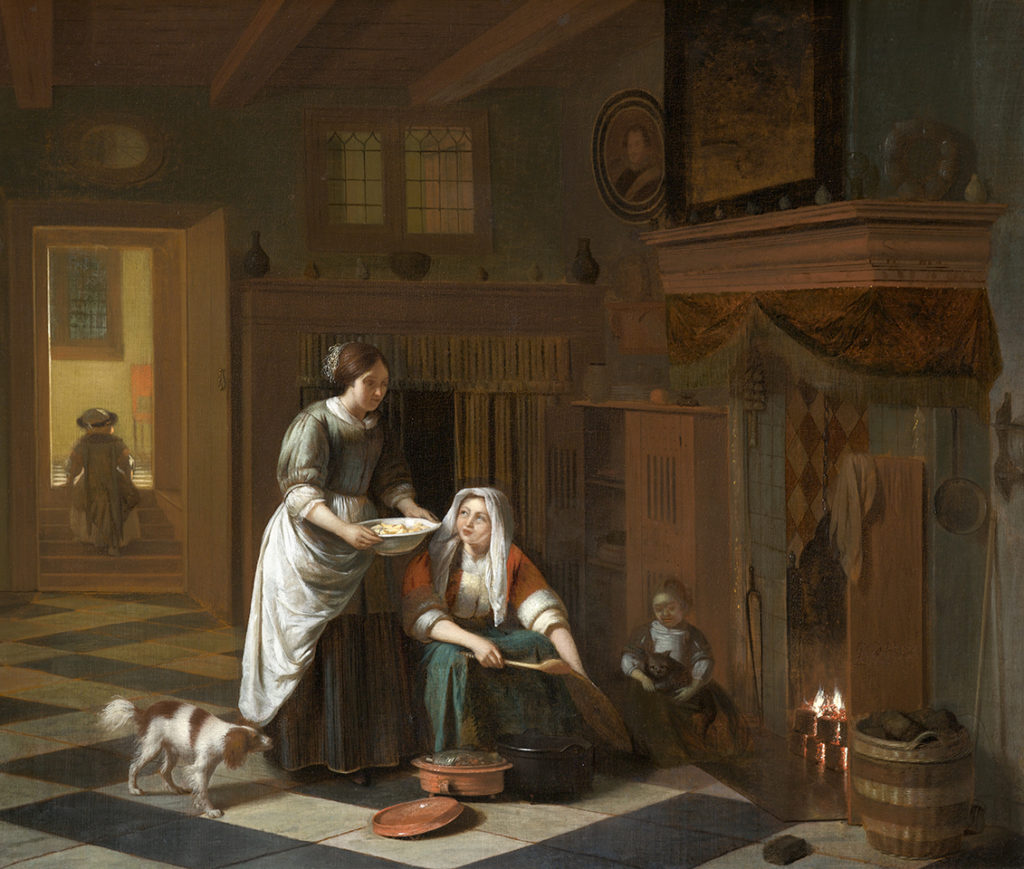Firebacks are, themselves, pictures, with their decorative elements often framed. Some, like those produced in Germany in the 16th and 17th century, and in England in the 18th century, are deliberately pictorial, with images copied from religious, mythological and other contemporary engravings and etchings. The well-known Lenard fireback of 1636, which portrays the founder at Brede Furnace in Sussex even includes a fireback among the domestic articles placed around his figure – a fireback depicting a fireback.
But firebacks have also, occasionally, been featured in other works of art. Their inclusion has usually been incidental, as part of the background of a scene in which other elements have been the main subject. In the earliest example I have found, however, the presence of firebacks in the composition has been deliberately intended to provide detail in support of one of the principal elements of the painting.
Marten van Valckenborch (1535-1612) and his brother Lucas were Flemish artists who followed the example of the famous Pieter Breughel in painting landscapes populated by scenes of vernacular life. Both portrayed the countryside in which they had grown up, in present-day Belgium, and which frequently included the rugged scenery of the Meuse valley and the ironworks that were to be seen there. Sometimes the ironworks were incidental, such as in Marten’s painting of the biblical Tower of Babel (a popular subject for artists of the period) in which a furnace and forge can be made out in the bottom left corner, presumably making castings and forgings for the construction of the Tower. In others the industrial scene formed the subject itself, as in this painting of 1612.

In most of these and other paintings by the van Valckenborch brothers the arrangement of the furnace, forge and mining activity follows similar lines, probably worked up from first-hand sketches of an actual ironworks and used over and over again with slight variations. Examination of the detail of this picture, however, reveals firebacks and either stoveplates or memorial slabs propped against the wall of the furnace stack from which ironworkers are running molten metal to form an ingot or sow that will be taken to the forge nearby. The painting itself is evidence of the production of firebacks in Wallonia in the early-17th century.

Many firebacks from the near continent were imported into England later in the 17th century. Most came from the Netherlands where their placement in houses began in earnest once politically more settled times followed the Peace of Münster in 1648 which brought the Eighty Years War to an end and gave the Dutch independence from Spain. It is in the genre of Dutch interior paintings that firebacks begin to appear as part of the domestic scene. The principal creator of such pictures was Pieter de Hooch (1629-after 1684) and the example below shows the group sitting by the fireplace where a fireback of a distinctive shape can just be seen.


Another painting of a very similar subject is this one by Cornelis de Man (1621-1706) in which the fireback can be seen more prominently. In both of these and others by Dutch artists of the same period, the settings are much the same and the firebacks are no more or less important than the tiles on the wall or the furniture, ornaments or paintings in the rooms portrayed. Firebacks were clearly common features of Dutch homes.


As much as two centuries later is an English interior which features a fireback. Pictured is the great Victorian engineer William, Lord Armstrong relaxing at Cragside, his house in Northumberland in a painting by H. H. Emerson. At the back on the right a fireback reflects the glow of the fire. Now a property belonging to the National Trust, the room has remained as it is shown in the painting and the fireback is still behind the fire grate. It is one of the EB series and shows a mounted figure in classical dress, possibly intended to be William III.

Firebacks appear in one or two paintings by the Surrey artist Ernest Christie (1863-1937) whose favourite subject was timber-framed buildings and the things associated with them, such as firebacks, hearths and water pumps. The Surrey History Centre at Woking has a large collection of Christie’s paintings given to the Surrey Archaeological Society. In the pictures the firebacks are significant features of the interiors.


Finally, a painting specifically of a fireback. Cedric Morris (1889-1982) was an influential artist, teacher and plantsman who was based for much of his life in East Anglia. One of his students was Lucian Freud. The painting is undated and the fireback which is the subject is intriguing with its two dancing figures and the sun and wreathed mask. So unlike any other fireback I had seen, I was tempted to dismiss it as not from Sussex at all until I was shown a letter dated 1981 received by the Sussex Archaeological Society from a correspondent in London, who apparently was its owner. Attached to it was this photograph of the very same fireback and the information that it had been dug up in a garden at Wilmington in Sussex in the 1930s and that it measured about 3 ft (91cm) wide by 2 ft 6 in (76cm) high. It would be interesting to discover where the fireback is now.


